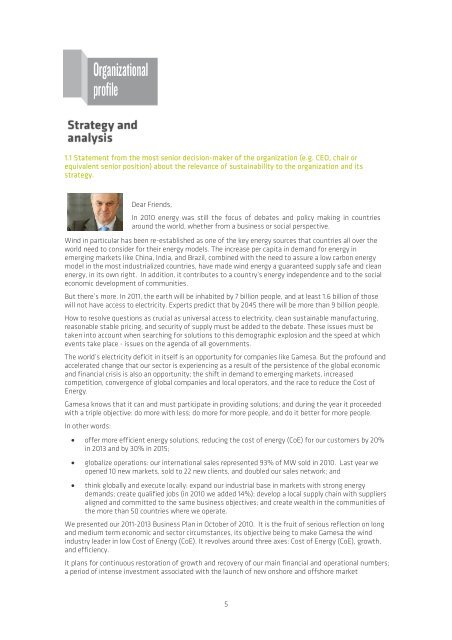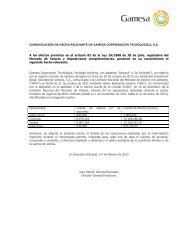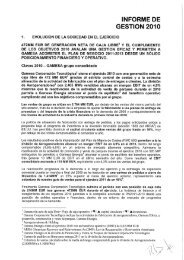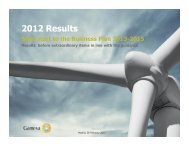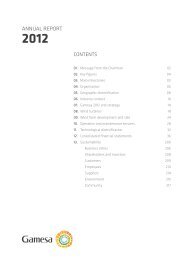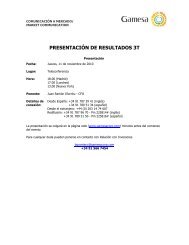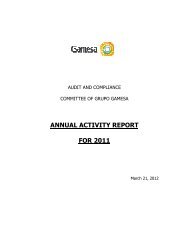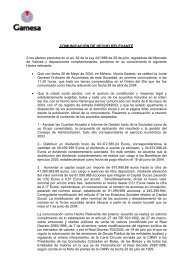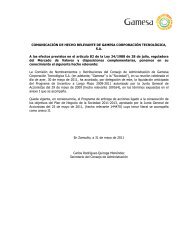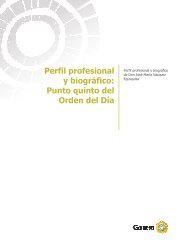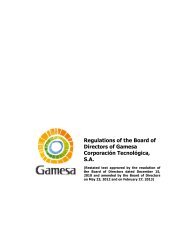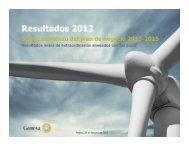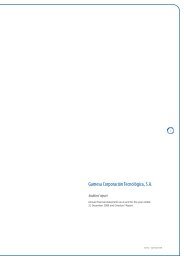Sustainability Report 2010 - Gamesa
Sustainability Report 2010 - Gamesa
Sustainability Report 2010 - Gamesa
Create successful ePaper yourself
Turn your PDF publications into a flip-book with our unique Google optimized e-Paper software.
1.1 Statement from the most senior decision-maker of the organization (e.g. CEO, chair or<br />
equivalent senior position) about the relevance of sustainability to the organization and its<br />
strategy.<br />
Wind in particular has been re-established as one of the key energy sources that countries all over the<br />
world need to consider for their energy models. The increase per capita in demand for energy in<br />
emerging markets like China, India, and Brazil, combined with the need to assure a low carbon energy<br />
model in the most industrialized countries, have made wind energy a guaranteed supply safe and clean<br />
energy, in its own right. In addition, it contributes to a country’s energy independence and to the social<br />
economic development of communities.<br />
But there’s more. In 2011, the earth will be inhabited by 7 billion people, and at least 1.6 billion of those<br />
will not have access to electricity. Experts predict that by 2045 there will be more than 9 billion people.<br />
How to resolve questions as crucial as universal access to electricity, clean sustainable manufacturing,<br />
reasonable stable pricing, and security of supply must be added to the debate. These issues must be<br />
taken into account when searching for solutions to this demographic explosion and the speed at which<br />
events take place - issues on the agenda of all governments.<br />
The world’s electricity deficit in itself is an opportunity for companies like <strong>Gamesa</strong>. But the profound and<br />
accelerated change that our sector is experiencing as a result of the persistence of the global economic<br />
and financial crisis is also an opportunity; the shift in demand to emerging markets, increased<br />
competition, convergence of global companies and local operators, and the race to reduce the Cost of<br />
Energy.<br />
<strong>Gamesa</strong> knows that it can and must participate in providing solutions; and during the year it proceeded<br />
with a triple objective: do more with less; do more for more people, and do it better for more people.<br />
In other words:<br />
Dear Friends,<br />
In <strong>2010</strong> energy was still the focus of debates and policy making in countries<br />
around the world, whether from a business or social perspective.<br />
offer more efficient energy solutions, reducing the cost of energy (CoE) for our customers by 20%<br />
in 2013 and by 30% in 2015;<br />
globalize operations: our international sales represented 93% of MW sold in <strong>2010</strong>. Last year we<br />
opened 10 new markets, sold to 22 new clients, and doubled our sales network; and<br />
think globally and execute locally: expand our industrial base in markets with strong energy<br />
demands; create qualified jobs (in <strong>2010</strong> we added 14%); develop a local supply chain with suppliers<br />
aligned and committed to the same business objectives; and create wealth in the communities of<br />
the more than 50 countries where we operate.<br />
We presented our 2011-2013 Business Plan in October of <strong>2010</strong>. It is the fruit of serious reflection on long<br />
and medium term economic and sector circumstances, its objective being to make <strong>Gamesa</strong> the wind<br />
industry leader in low Cost of Energy (CoE). It revolves around three axes: Cost of Energy (CoE), growth,<br />
and efficiency.<br />
It plans for continuous restoration of growth and recovery of our main financial and operational numbers;<br />
a period of intense investment associated with the launch of new onshore and offshore market<br />
5


